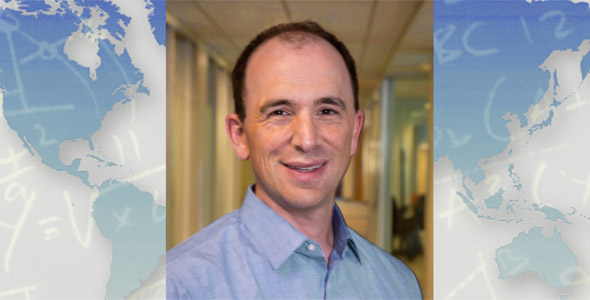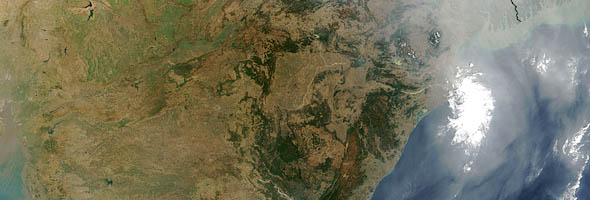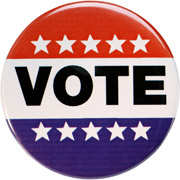ELECTION INSIGHTS 2016
Research-based perspectives from MIT
On the Economic Impacts of Climate Change | Benjamin Olken
Professor of Economics and Co-Director of the Abdul Latif Jameel Poverty Action Lab

"The increase in average temperature translates into many more extremely hot days. These matter, even in the United States: Eesearchers have found that the increased number of extremely hot days has led to lower agricultural yields, lower economic activity in industries exposed to outdoor temperatures, such as construction and mining, and even to increased mortality."
— Benjamin Olken, Professor of Economics and Co-Director of the Abdul Latif Jameel Poverty Action Lab
ELECTION INSIGHTS 2016
Research-based perspectives from MIT
Question
Conflicting public attitudes about climate change — among both voters and the candidates — have been a factor in the 2016 presidential election. Based on your research and expertise about the economics of climate change, how do you assess the candidates’ positions on climate change issues, and what is the most important finding or perspective about climate change that would be useful for an American voter to know?
•
Climate policy is an area where the two major presidential candidates are diametrically opposed. Donald Trump promises to cancel the Paris climate change agreement and rescind President Obama’s executive orders on climate, such as his Clean Power Plan; Hillary Clinton promises to deliver on the Paris pledges, implement and extend Obama’s Clean Power Plan, invest in renewable energy, and reduce American oil consumption by a third.
These are substantial differences. The Paris plan is an attempt to coordinate countries on a sequence of global emissions plans that collectively could help limit average temperature increases to two degrees Celsius. The core of the plan is that each country in the world commits to a series of greenhouse gas emission targets that, collectively, would help limit the extent of global climate change. By many metrics this is a fairly mild plan: Each country basically chooses its own emissions targets, and while this may reduce emissions, there is no guarantee that this will be enough to reach the global target.
The differences are equally stark on power. The Obama Clean Power Plan sets targets for each state's power plant emissions, but then allows states flexibility in how they implement them. Clinton aims to implement and extend this plan; Trump promises to cancel it.
Differences about whether climate change is real
The key difference that lies behind these different policies is the candidates’ views on climate change: Clinton embraces it as real, as man-made, and as an important challenge, whereas Trump has on multiple occasions called climate change a “hoax.” His policies can be understood generously in this light: If Trump indeed believes climate change is not real, there is no reason for him to support the Paris plan or the Obama Clean Power Plan.
There is a deep scientific consensus, as exemplified by reports from organizations such as the International Panel on Climate Change, the National Academy of Sciences, and others that climate change is real and caused by human-induced emissions. And the effects of climate change are likely already being felt: NASA estimates that average global temperatures have already increased by 0.8 degrees Celsius (1.4 degrees Farenheit).

"Sorting out the optimal response to these effects is complex, but a prerequisite for doing so is acknowledging that climate change is real."
Impact: food, economics, mortality
This increase in average temperature translates into many more extremely hot days. These matter, even in the United States: researchers have found that the increased number of extremely hot days has led to lower agricultural yields (Burke and Emerick 2016), lower economic activity in industries exposed to outdoor temperatures, such as construction and mining (Graff Zivin and Neidell 2014), and even to increased mortality (Deschenes and Greenstone 2011).
For poor countries, the effects are even seen on overall economic output: My own research suggests that each additional degree of warming lowers economic growth in poor countries by more than 1 percentage point each year (Dell, Jones, and Olken 2012). Sorting out the optimal response to these effects is complex, but a prerequisite for doing so is acknowledging that climate change is real in the first place.
Of course, climate policy is only one issue in this election. But on this issue, the candidates are far apart and the differences are clear.
Suggested links
ELECTION INSIGHTS 2016
Research-based perspectives from MIT
Abdul Jameel Latif Poverty Action Lab
News Archive: Benjamin Olken on the economic impact of climate change
News Archive: The economic cost of increased temperatures
How to Vote in Every State
See video with info for your state — and vote!
References
Burke, M and K Emerick, 2016. "Adaptation to Climate Change: Evidence from U.S. agriculture." American Economic Journal: Economic Policy, 8(3): 106-140.
Dell, M, BJ Jones and BA Olken, 2012. “Temperature Shocks and Economic Growth: Evidence from the Last Half Century,” American Economic Journal: Macroeconomics 4 (3): 66-95.
Deschenes, O and M Greenstone, 2011. “Climate Change, Mortality, and Adaptation: Evidence from Annual Fluctuations in Weather in the U.S.” American Economic Journal: Applied Economics, 3(4): 152-185.
Intergovernmental Panel on Climate Change, 2014. “Climate Change 2014: Synthesis Report. Contribution of Working Groups I, II and III to the Fifth Assessment Report of the Intergovernmental Panel on Climate Change” [Core Writing Team, R.K. Pachauri and L.A. Meyer (eds.)]. IPCC, Geneva, Switzerland.
Graff Zivin, J and M Neidell, 2014. “Temperature and the Allocation of Time: Implications for Climate Change.” Journal of Labor Economics, 32: 1-26.
Royal Society and U.S. National Academy of Sciences, 2014. “Climate Change: Evidence & Causes.”
